Origins of Portsmouth and Southsea Road names
Explore the Historical Roots of Portsmouth and Southsea road names
Portsmouth and Southsea, once a modest military garrison town in Old Portsmouth, experienced a rapid transformation during the 1800s. This growth extended east and northward across Portsea Island, shaping the vibrant city we know today.
Delve into the city's past through its intricate network of roads, each bearing fascinating tales of their own. Many road names echo the city's military and naval heritage, such as the Havelock Park and Nelsonville areas. But the streets of Portsmouth and Southsea are also adorned with the legacies of politicians, royal affiliations, and unique themes that paint a colorful historical picture.
For instance, venture into Cosham, where road names like Totland, Freshwater, and Colwell are all named after Isle of Wight locations. Explore the mineral estate just off Kings Road, where streets proudly bear names like Gold, Silver, Copper, Flint, and Stone, reflecting geological materials.
In Eastney, there is a cluster of roads honoring towns in the New Forest, including Ringwood Road, Fordingbridge Road, Cadnam Road, and Minstead Road.
Embark on a captivating exploration of Portsmouth and Southsea's evolution, where many road names unveil a unique chapter of the city's vibrant history. Join us as we journey through time and uncover the captivating stories behind these city streets.
Not all of the street names in Portsmouth and Southsea have obvious origins but hopefully we can illustrate as many as possible here. Is your road or street mentioned?
A
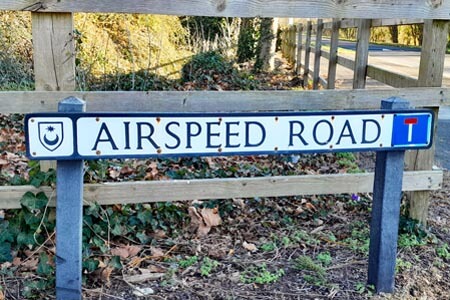
Airport Service Road, Portsmouth
Airport Service Road runs from the Eastern Road, just north of the Golf Course. It used to be the access road to Portsmouth Airport hence it's name.
Airspeed Road, Portsmouth
Airspeed Road is a side road off of Airport Service Road. It is named after Airspeed Ltd, founded by AH Tiltman and Nevil Shute Norway (the aeronautical engineer and novelist), who had a factory at this site building aircraft such as the Airspeed Courier and the Airspeed Envoy, which flew from Portsmouth Airport.
Alec Rose Lane, Portsmouth
Alec Rose Lane runs between Isambard Brunel Road and Guildhall Walk, at the side of the Central Library in Portsmouth city centre. It is named after Alec Rose a greengrocer from Southsea who single handedly circumnavigated the globe with his yacht Lively Lady in 1967-68. He was knighted and was granted freedom of the city of Portsmouth in 1968. His yacht Lively Lady is now owned by the charity Around and Around and can be seen moored at Port Solent Marina.
Allaway Avenue, Paulsgrove
Allaway Avenue runs east to west from Southampton Road until it becomes Jubilee Avenue in the west. Allaway Avenue is named after Alderman Albert Edward Allaway, Lord Mayor in 1944-5 and 1945-6, a campaigner for improvements to local housing.
B
Balfour Road, North End
Balfour Road runs between Kirby Road and Chichester Road, it was named after Arthur James Balfour, 1st Earl of Balfour, KG, OM, PC, FRS, FBA, DL, also known as Lord Balfour, a Conservative who served as Prime Minister from 1902 to 1905.
Beresford Road, North End
Beresford Road in North End, runs between Chichester Road and Kirby Road. It was named after Admiral Charles William de la Poer Beresford, 1st Baron Beresford. He had two careers being a Member of Parliament and an Admiral in the Royal Navy.
C
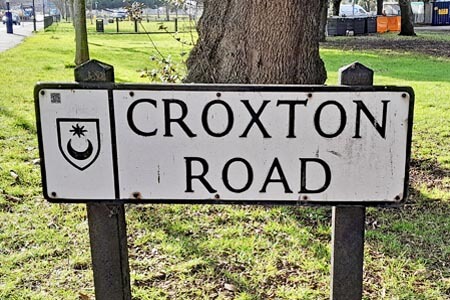
Campbell Road, Southsea
Campbell Road runs east from Victoria Road north to Lawrence Road. This area of Southsea was developed in 1857 and was known as Havelock Park. All of the road names in the Havelock Park area were named after military officers involved in the fight against the Indian Mutiny a major uprising in India in 1857-58 against the rule of the British East India Company. Campbell Road is named after Field Marshal Sir Colin Campbell, Commander-in-chief in India who led the relief army during the Indian Mutiny of 1857.
Clarence Parade, Southsea
Clarence Parade was built during the development of Southsea Seafront in 1848 and is named after Lieut General Lord Fitzclarence, illegitimate son of King William IV, who was the Lieutenant-Governor of Portsmouth between 1847 and 1851.
Claybank Road, Portsmouth
Claybank Road a commercial and industrial location, which runs north from Burrfields Road, was probably named after the activities that took place there. In the 1890s brickworks dominated this area and there were three clay pits and five kilns in production here. The next road to the east is called Kiln Road.
Cockleshell Gardens, Eastney
Cockleshell Gardens is a cul-de-sac off of Henderson Road in Eastney. It is named to commemorate the Cockleshell Heroes a unit of Royal Marines who carried out a daring and costly raid on German shipping in Bordeaux harbour during World War Two. The area where Cockleshell Gardens is located was originally part of the former Royal Marines Barracks.
Collingwood Road, Southsea
Collingwood Road in Southsea runs parallel to Albert Road between Exmouth Road and Napier Road. This area of Southsea's development in the 1860's was known as Nelsonville. Collingwood Road is named after Vice Admiral Cuthbert Collingwood, 1st Baron Collingwood who fought with Admiral Lord Nelson at the Battle of Trafalgar 1805, Collingwood led the second naval column at the battle.
Croxton Road, Southsea
Possibly the shortest road in Portsmouth, Croxton Road lies between Pier Road and Victoria Avenue near the Holiday Inn. Croxton Road in named after Thomas Croxton a property developer in the early 1800s who built houses in the Kings Road, Hampshire Terrace area, known as Croxton Town, later called Southsea.
D
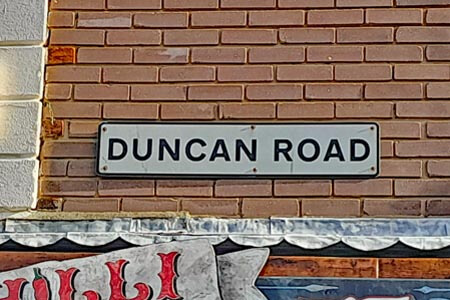
Dorothy Dymond Street, Portsmouth
Dorothy Dymond Street in Portsmouth, is a short street located at the rear of the Portsmouth Central Library. It is named after Dorothy Dymond, a historian and educationalist, she was appointed Principal of Portsmouth Training College in 1932. She served on the University Grants Committee 1946-1953 and was President of the Association of Teachers in Colleges and Departments of Education 1957-61 She was awarded a CBE in the New Year's Honours list in 1949 and an honorary D.Litt by Southampton University in 1976.
Duncan Road, Southsea
Duncan Road which runs south from Albert Road. This area was know as Nelsonville when it was first developed in 1861 and many of the road names are taken from naval contemporaries of Admiral Lord Nelson. Duncan Road is named after Admiral of the Fleet Adam Duncan (1731-1804) who successfully defeated the Dutch fleet at the Battle of Camperdown in 1797.
E
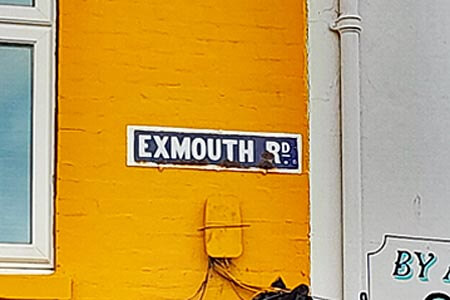
Elphinstone Road, Southsea
Elphinstone Road is located between Kent Road and Osborne Road in Southsea. The road was named after Sir James Dalrymple Horn Elphinstone who was Conservative MP for Portsmouth, 1857-1865 and 1868-1880. He also served as a naval officer for the Honourable East India Company and retired as a Commander in 1834.
Exmouth Road, Southsea
Exmouth Road which runs south from Albert Road to St Vincent Road. This area was know as Nelsonville when it was first developed in 1861 and many of the road names are taken from naval contemporaries of Admiral Lord Nelson. Exmouth Road is named after Admiral Edward Pellew, 1st Viscount Exmouth, GCB (1757- 1833) a British naval officer. He fought during the American War of Independence, the French Revolutionary Wars, and the Napoleonic Wars.
F
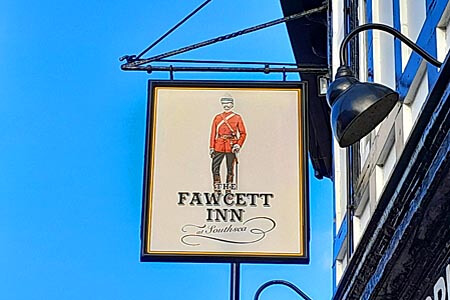
Fawcett Road, Southsea
Fawcett Road in Southsea runs from Fratton bridge heading south to the junction with Lawrence Road, where the Fawcett Inn pub is located, here it veers to the west slightly, ending at Albert Road with the Bold Forester on the corner. The road was developed around 1896 and was formerly known as Lazy Lane.
Both Fawcett Road and the Fawcett Inn are named after Lieutenant Alexander Fawcett who was shot and died aged 20 fighting in the First Indian War of Independence. There is a memorial to him at St Thomas' Cathedral in Old Portsmouth which reads "In memory of Alexander Fawcett. Lieu H.M 95th Reg who was shot at Bejapore India whilst gallantly leading his company against the mutineers. September 5th 1858. In the 20th year of his age. Deeply regrettably all who knew him."
Fearon Road, North End
From 1543 onwards much of the land which is now the area known as North End was owned by Winchester College. Fearon Road was built from 1911 onwards and appears to have been named after William Andrewes Fearon (1841-1924) who was Headmaster of Winchester College from 1884 to 1901 and Archdeacon of Winchester 1903-1920.
Fort Cumberland Road, Eastney
Fort Cumberland Road runs from Henderson Road eastwards until it becomes Ferry Road near Southsea Marina. The road is named after Fort Cumberland a pentagonal military fortification overseen by English Heritage on the peninsular at Eastney.
G
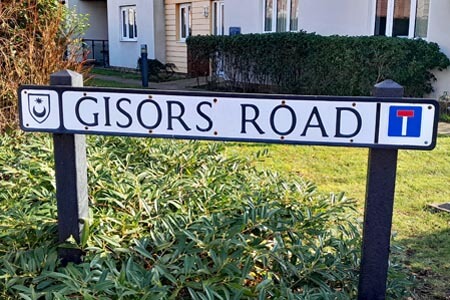
Gisors Road, Southsea
Gisors Road is on the south side of Locksway Road, where the teachers training college used to be. Gisors Road is named after Jean de Gisors a French lord, between 1170 and 1180 he purchased the manor of Buckland from the de Porte family. He is acknowledged as the founder of what was to become the city of Portsmouth.
Gladys Avenue, North End
Gladys Avenue runs south from Northern Parade to the junction at London Road and Stubbington Avenue in North End.
Alfred White was a local businessman instrumental in the introduction of the tram system to Portsmouth. In recognition of his work Mr White was given the honour of naming a road, he chose Gladys Avenue, naming it after his daughter. Gladys was a nurse who trained at Guy's Hospital in London, served during World War 1 and was awarded the Florence Nightingale Medal in recognition of her war service.
Goldsmith Avenue, Milton
Goldsmith Avenue was formerly known as Canal Road as it follows the course of the old Portsmouth to Arundel Canal. When the area was redeveloped in the late 1890s it was renamed Goldsmith Avenue after James Goldsmith a wealthy landowner owner of the Milton Farm Estate, part of which was retained as the present Milton Park.
H
Havelock Road, Southsea
Havelock Road is just to the east of Victoria Road north in Southsea. This area of Southsea was developed in 1857 and was known as Havelock Park. All of the road names in the Havelock Park area were named after military officers involved in the fight against the Indian Mutiny a major uprising in India in 1857-58 against the rule of the British East India Company. Havelock Road is named after Major-General Sir Henry Havelock a British general particularly associated with India and his recapture of the city of Cawnpore (now Kanpur).
Hawke Street, Portsea
Hawke Street runs south off of Queen Street alonside the Royal Maritime Club in Portsea. Hawke Street was named after Admiral Edward Hawke whose naval victory in 1759 put an end to French plans to invade Great Britain during the Seven Years War (1756-63).
Hendy Close, Southsea
Hendy Close is a short cul-de-sac just off of Grove Road South in Southsea. It is named after the Hendy Lennox garage and petrol station which used to occupy the site. The new garage opened as Lennox Motor Co. Ltd in 1938 and was a purpose built art deco car dealership and repair shop for Ford cars. It was finally demolished in 1995 and the area was redeveloped into a residential street.
Highland Road, Eastney
Highland Road runs east from the junction of Albert Road and Fawcett Road. It is not clear whether the road was named after Highland Cottage a landmark building in the area from 1833 onwards. Alternatively it may have been named due to its position at the northern edge of Southsea Common and the Great Morass on relatively high ground. Bearing in mind that most of Portsea Island is less than 3 metres (9.8 ft) above sea level.
I
Inglis Road, Southsea
Inglis Road runs between Chelsea Road and Lawrence Road. This area of Southsea was developed in 1857 and was known as Havelock Park. All of the road names in the Havelock Park area were named after military officers involved in the fight against the Indian Mutiny a major uprising in India in 1857-58 against the rule of the British East India Company. Inglis Road is named after Major General Sir John Inglis a British Army officer, known for his role in protecting the British compound for 87 days during the siege of Lucknow.
K
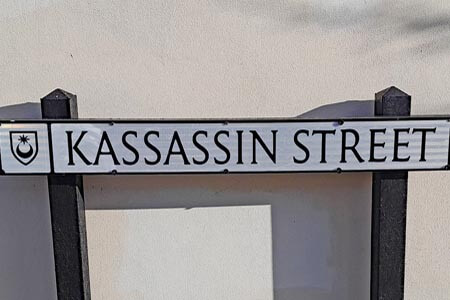
Kassassin Street, Eastney
Kassassin Street in Eastney runs parallel to Cromwell Road, between Highland Road and Worsley Street, close to Eastney Barracks.
The street was named in reference to two battles fought by the Royal Marine Light Infantry and Royal Marine Artillery at Kassassin, Egypt in 1882.
Kenilworth Road, Southsea
Kenilworth Road runs parallel to Waverley Road between St Simons Road and Clarendon Road. The road is named in reference to the Walter Scott novel series, historical novels published in three volumes and known as the Waverley novels. Kenilworth was published in 1821. Other Scott roads in the area include Waverley (a novel published 1825) and St Ronan's (after the novel St Ronan's Well published 1823)
Kiln Road, Portsmouth
Kiln Road is located in a commercial and industrial location, which runs north from Burrfields Road, was probably named after the activities that took place there. In the 1890s brickworks dominated this area and there were three clay pits and five kilns in production here. The next road to the west is called Claybank Road.
L
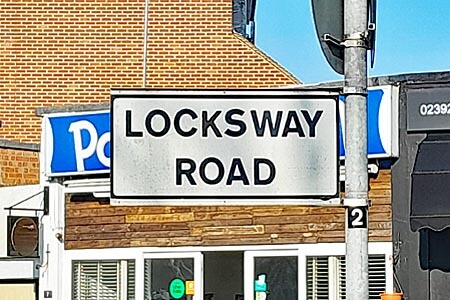
Lake Road, Portsmouth
Lake Road which runs east/west between London Road at North End to Commercial Road, was named because there was a lake situated at the western end.
Locksway Road, Milton
Locksway Road, formerly Asylum Road, runs east from Milton Road to Furze Lane. The road was originally named after the Portsmouth Borough Asylum (St James' Hospital) which opened in 1879 and is located just to the north of the road. It was later renamed Locksway Road reflecting its location running parallel to the old Portsmouth to Arundel Canal which had sea locks opening onto Langstone Harbour at the eastern most end of the road.
Lowcay Road, Southsea
Lowcay Road runs between Waverly Road and Wimbledon Park Road in Southsea. The road was named after Captain William Lowcay a Midshipman on HMS Ajax at the Battle of Trafalgar in 1805.
M
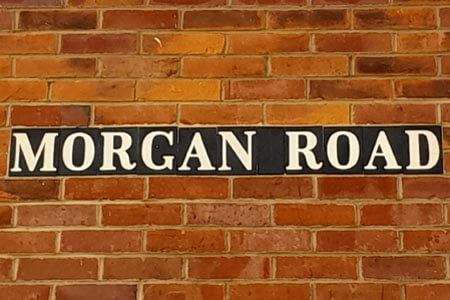
Marmion Road, Southsea.
Marmion Road runs between Victoria Road South and Grove Road South, this area was formerly occupied by Marmion Farm, after which marmion Road is named.
Moorings Way, Milton.
Moorings Way runs east from the Eastern Road skirting Milton Common and meets Furze Lane. Milton Common used to be a tidal inlet, part of Langstone Harbour, this land was later infilled between the 1950s and 1970s and reclaimed from the sea. Moorings Way is named in reference to the large number of houseboats that were moored on the shore there. These were inhabited by families displaced by wartime bombing during The Blitz of WW2.
Morgan Road, Milton
Morgan Road is a short cul de sac running between Locksway Road and the course of the old canal. The road was named after EA Morgan a property developer in the 1920's, his business colleague was Mr EC Trevis. Trevis Road is a little further east along Locksway Road.
N
Napier Road, Southsea
Napier Road runs south from Albert Road to the junction with Wimbledon Park Road. This area was know as Nelsonville when it was first developed in 1861 and many of the road names are taken from naval contemporaries of Admiral Lord Nelson. Napier Road is named after William John Napier, 9th Lord Napier, he enlisted in the Royal Navy in 1803 and served as a midshipman on HMS Defiance at the Battle of Trafalgar (1805).
Nevil Shute Road, Hilsea
Nevil Shute Road runs south off of Airport Service Road, parallel to the railway, it is part of an industrial estate. The road is named after Nevil Shute (Norway) the English novelist and aeronautical engineer. Co founder of Airspeed Ltd an aircraft manufacturer which was based at Portsmouth Airport from 1933. Shute wrote 24 novels the most well known being On the Beach and A Town Like Alice. Norway Road in Hilsea is also named after Nevil Shute his actual surname being Norway.
Newcomen Road, Stamshaw
Newcomen Road in Stamshaw runs east from Twyford Avenue to Stamshaw Park. It is named after Thomas Newcomen an English inventor who created the atmospheric engine (steam engine), the first practical fuel-burning engine in 1712.
North Street, Portsea
North Street, that runs north from Queen Street in Portsea, was named after Lord North the 12th Prime Minister of Great Britain from 1770 to 1782. Frederick North, 2nd Earl of Guilford KG, PC, better known by his courtesy title Lord North was Prime Minister when Great Britain was defeated during the American War of Independence.
O
Old Bridge Road, Southsea.
Old Bridge Road runs between Craneswater Avenue and St Ronans Road in Southsea. Between 1885 and 1914 trains used to run from Fratton Station travelling directly into the heart of Southsea to East Southsea Railway Station. Old Bridge Road is named after the railway bridge which occupied this site at that time.
Onslow Road, Southsea
Onslow Road runs south from Clarendon Road to St Catherine Street and is named in honour of Sir Richard Onslow. 1st Baronet, GCB 1741 - 1817 an English naval officer who played a commanding role at the Battle of Camperdown fought by the British and Dutch navy's.
Outram Road, Southsea
Outram Road runs from the west end of Havelock Road south to the junction with Elm Grove in Southsea. This area of Southsea was developed in 1857 and was known as Havelock Park. All of the road names in the Havelock Park area were named after military officers involved in the fight against the Indian Mutiny a major uprising in India in 1857-58 against the rule of the British East India Company. Outram Road is named after Lieutenant General Sir James Outram a British general who fought in the Indian Rebellion of 1857.
P
Palmerston Road, Southsea
Palmerston Road has been Southsea's main shopping street since Victorian times, running south from Kent Road to Osborne Road. The road was named after Viscount (Lord) Palmerston who was twice Prime Minister of the UK in the mid-19th century. Palmerston responsible for building a series of forts, the Solent Forts and at Portsdown Hill, built to protect Portsmouth harbour and its dockyard.
Powerscourt Road, North End
Powerscourt Road in North End runs from Kingston Road in the west across to Copnor Road in the west. The road is names after Lord Powerscourt (of Powerscourt, Co. Wicklow, Ireland) owned and leased land on Portsea Island.
Prince Albert Road, Eastney
Prince Albert Road runs north from Highland Road up to Goldsmith Avenue, crossing Devonshire Avenue about half way up. The road is named after Albert the Prince Consort who was married to Queen Victoria from 1840 until his death in 1861.
Q
Queen Street, Portsea
Queen Street is the main road running down from St John's Cathedral to The Hard at Portsmouth Harbour. Queen Street is named after Queen Anne.
S
St Barbara Way, Hilsea
St Barbara Way is located in Gatcombe Park in Hilsea. This area was formerly an army barracks, Hilsea Barracks, the road is named after St Barbara's Church which was part of the barracks, demolished in 1965.
St Ronan's Road, Southsea
St Ronan's Road runs south from Albert road to it's junction with Waverley Road. The road is named in reference to the Walter Scott novel series, historical novels published in three volumes and known as the Waverley novels. St Ronan's Well was published in 1823. Other Scott roads in the area include Waverley (a novel published 1825) and Kenilworth (a novel published in 1821.)
Somers Road, Portsmouth
Somers Road runs south from Winston Churchill Avenue to Cottage Grove. It is named after Mr Somers a property developer who owned the land in this area, it was developed during the 1820s and became know as Somers Town.
Stubbington Avenue, North End
Stubbington Avenue which runs between Copnor Road and London Road at North End, is named after Stubbington Farm which used to occupy this area prior to being built on.
Sultan Road, Buckland
Sultan Road runs west from Hanway Road in North End, it is believed that the road is named after Sultan Adbulaziz of Turkey who visited Portsmouth in 1870.
T
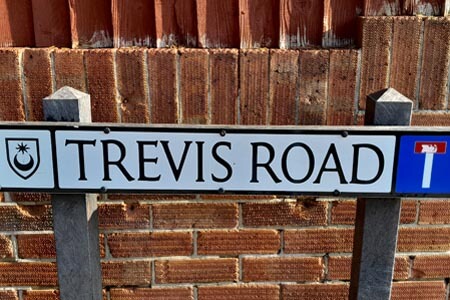
The Ocean at the End of The Lane
Located next to the SW tip of Canoe Lake, The Ocean at the End of The Lane is a bus lane running from St Helens Parade onto Eastney Esplanade (seafront). Named after The Ocean at the End of the Lane a 2013 novel by Neil Gaiman. Gaiman's family originally from Polish Jewish roots, settled in Portsmouth and had a successful grocery shop chain, Neil's early years were spent in Portchester before his family moved to East Grinstead.
Trevis Road, Milton.
Trevis Road is a cul de sac off of Locksway Road in Milton the southern end of which would have joined the bank of the old canal. The road was named after EC Trevis a property developer in the 1920's.
V
Velder Avenue, Milton.
Velder Avenue runs from the end of the Eastern Road at the Good Companion Pub, up to the junction with Milton Road. This area was originally a tidal inlet, part of Langstone Harbour, known as Felder Lake. The name Velder Avenue is derived from this.
W
Waverley Road, Southsea
Waverley Road runs south from the junction of Albert Road and Lawrence Road. The road is named in reference to the Walter Scott novel series, historical novels published in three volumes and known as the Waverley novels. Waverley was published in 1825. Other Scott roads in the area include Kenilworth (a novel published 1821) and St Ronan's (after the novel St Ronan's Well published 1823)
Wilson Grove, Southsea
Wilson Grove runs from Outram Road looping back to Campbell Road. This area of Southsea was developed in 1857 and was known as Havelock Park. All of the road names in the Havelock Park area were named after military officers involved in the fight against the Indian Mutiny a major uprising in India in 1857-58 against the rule of the British East India Company. Wilson Grove is named after Lieutenant General Sir Archdale Wilson a British Bengal Army and British Army artillery officer praised for his role in the relief of Lucknow.
Winston Churchill Avenue, City Centre
Winston Churchill Avenue is named after the former Prime Minister and wartime leader Winston Leonard Spencer Churchill. Churchill was granted the freedom of the City of Portsmouth in December 1950. Churchill visited Portsmouth on numerous occasions, he held the position of First Lord of the Admiralty in the early months of both world wars.
Worsley Road, Southsea
Worsley Road which runs south from Elm Grove to St Edwards Road in Southsea, is thought to be named after the Worsleys of Appuldurcombe, IOW the Worsley family is an English family that is derived from Sir Elias de Workesley, a Norman knight. The seat of the Worsley family, Appuldurcombe was once the grandest house on the Isle of Wight.
Wykeham Road, North End
From 1543 onwards much of the land which is now the area known as North End was owned by Winchester College. Wykeham Road, which runs between Lyndhurst Road and Balfour Road, was named after William of Wykeham, Bishop of Winchester and Chancellor of England, who founded the college in 1382.